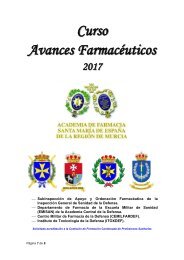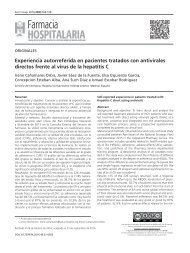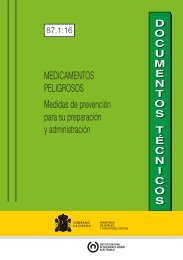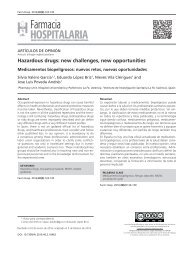155_10465
155_10465
155_10465
You also want an ePaper? Increase the reach of your titles
YUMPU automatically turns print PDFs into web optimized ePapers that Google loves.
376 - Farm Hosp. 2016;40(5):371-384 Rosario Santolaya-Perrín et al.<br />
Table 5. Molecules most frequently involved in<br />
STOPP-type inadequate prescriptions<br />
Molecule<br />
Frequency<br />
% out<br />
of total<br />
STOPP-PIPs<br />
Lorazepam 47 15.51<br />
ASA 27 8.91<br />
Bromazepam 21 6.93<br />
Lormetazepam 14 4.62<br />
Furosemide 11 3.63<br />
Alprazolam 9 2.97<br />
Digoxin 9 2.97<br />
Enalapril<br />
(alone or in combination)<br />
8 2.64<br />
Zolpidem 8 2.64<br />
Omeprazole 7 2.31<br />
Clonazepam 6 1.98<br />
Diazepam<br />
(alone or in combination)<br />
6 1.98<br />
Metamizole 6 1.98<br />
Clorazepate 5 1.65<br />
Colchicine<br />
(alone or in combination)<br />
5 1.65<br />
Diltiazem 4 1.32<br />
Glicazide 4 1.32<br />
Bisoprolol 3 0.99<br />
Budesonide 3 0.99<br />
Buprenorphine 3 0.99<br />
and col 20 evaluated the efficacy of an inter-level Pharmaceutical<br />
Care Program, with participation by Hospital,<br />
Primary Care and Community Pharmacists. Patients who<br />
were admitted to hospital were selected. These authors<br />
did not find any significant differences in re-admissions.<br />
As far as we know, no study has been published involving<br />
the coordination of the Hospital Pharmacist, the<br />
Emergency Physician and the Primary Care Physician.<br />
Outcomes will allow to assess the interest of developing<br />
this type of programs over other pharmaceutical care initiatives<br />
which have already demonstrated its utility.<br />
So far, the period of inclusion in the study has been<br />
completed, which allows to evaluate the prevalence of<br />
PIPs in those patients included. The result achieved was<br />
81.1% of patients, which is superior to that mentioned<br />
by other authors that have studied patients with a similar<br />
complexity index, and have found frequencies between<br />
35.9% and 61.3% 21-23 . However, it is lower than<br />
the one mentioned by Delgado and col 24 , who analyzed<br />
drug-related problems and PIPs in elderly patients, and<br />
found that 29% of the prescriptions analyzed were PIPs<br />
according to the STOPP criteria analyzed, vs. the 9.3%<br />
found in our study. A possible explanation could be that<br />
their study included patients with higher complexity,<br />
with many of them living in nursing homes.<br />
Regarding the qualitative analysis of PIPs, the majority<br />
are of the same type. Thus, 36.6% consist in the excessive<br />
use of benzodiazepines, and 7.9% consist in high doses<br />
of acetylsalicylic acid. Other authors have found similar<br />
data regarding inadequate use of benzodiazepines 22 .<br />
This is interesting, because the risk of falls and hospital<br />
admissions in elderly patients who use benzodiazepines<br />
has been well documented 25,26 ; therefore, based on these<br />
data, the design of educational strategies targeted to<br />
prescribing physicians and patients in order to reduce<br />
their use could become a priority.<br />
Regarding START criteria, the higher number of PIPs is<br />
due to the lack of anti pneumococcal vaccination according<br />
to the local protocol; but this could be due to the<br />
recent launch of the conjugated vaccine at the time of<br />
patient inclusion, and a reduction over time is expected.<br />
Another finding was the high frequency of the lack of<br />
use of statins in patients with vascular disease, as well<br />
as of ACE inhibitors in patients with heart failure. These<br />
results are similar to those reported by other authors 22,23 .<br />
Our study presents limitations. This is a study which<br />
requires a great level of coordination with Primary Care,<br />
and this can vary in the different participating centres.<br />
In order to minimize its influence, the centres involved<br />
were required to send to the coordinating centre a protocol<br />
for communication with Primary Care approved in<br />
the centre. Randomization was stratified by centre; and<br />
the method of communication and level of acceptance<br />
of the interventions conducted will be entered into the<br />
statistical analysis.<br />
Finally, it is worth mentioning that the study of these<br />
differences in communication between levels of care<br />
could be of great interest. In some centres, communication<br />
has been based in the use of computer tools. The<br />
development of these tools is necessary, but it does not<br />
assure that the physician responsible of the next level<br />
of care reads the recommendation. Some centres add<br />
an extra communication by e-mail, as a form of alert,<br />
to these computer media. Finally, one centre has incorporated<br />
the profile of Health Centre Manager, instead<br />
of using direct communication between professionals.<br />
The analysis of the differences in outcomes between<br />
centres can be useful in order to decide which Continuity<br />
of Care Procedure presents a higher utility. The ideal<br />
coordination model has not been determined, and the<br />
outcomes of this study can provide data to define it.<br />
Relación de investigadores participantes<br />
− Rosario Santolaya Perrín. Servicio de Farmacia. Hospital<br />
Universitario Príncipe de Asturias.<br />
− Gregorio Jiménez Díaz. Servicio de Urgencias. Hospital<br />
Universitario Príncipe de Asturias.<br />
− Erza Honan Roiz Andino. Servicio de Urgencias. Hospital<br />
Universitario Príncipe de Asturias.








